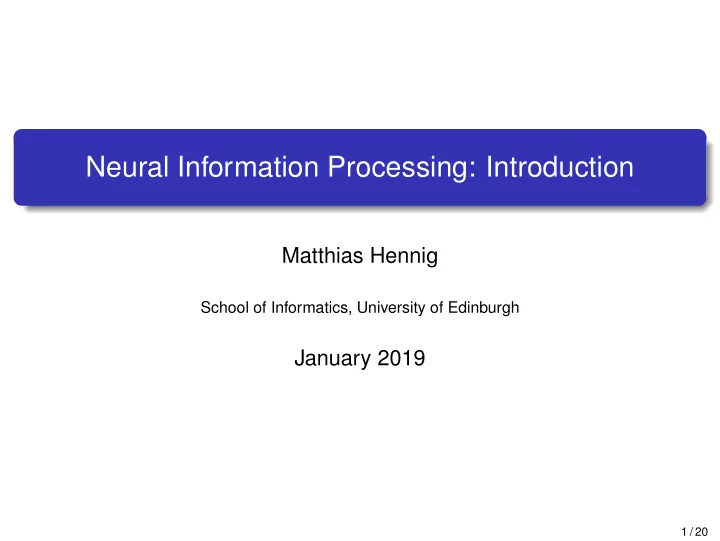

Neural Information Processing: Introduction Matthias Hennig School of Informatics, University of Edinburgh January 2019 1 / 20
Course Introduction Welcome and administration Course outline and context A short neuroscience summary 2 / 20
Administration All course materials will be posted on Learn. A Piazza forum will be used, access this via Learn. Complete (not assessed) homework before classes. Assessment is an exam (75%) and coursework (25%) Assignments: Assignment 1: 26 February 2019, 4pm Assignment 2: 5 April 2019, 4pm A1 will be an exercise, A2 will be on class papers. 3 / 20
Notes You need a good grounding in maths, specifically in probability and statistics vectors and matrices You do not need any background in neurobiology. I will work on the board/doc cam occasionally, make sure to take notes. Interrupt and ask questions in class if something is unclear, or you feel more explanation is useful. Treat everything shown as ’examinable’, except where explicitly said otherwise. Any questions/issues - please email m.hennig@ed.ac.uk. 4 / 20
Course aims This course will explore how the brain computes, how neuroscience can inspire technology, how computer science can help address questions in neuroscience. 5 / 20
Relationships to other courses NC Wider introduction, more biological, but less abstract than NIP CCN Cognition and coding, high level understanding (Peggy Series) PMR Pure ML perspective (Michael Gutmann) 6 / 20
Reading materials Course topics: Theoretical Neuroscience by Peter Dayan and Larry Abbott (MIT Press 2001) Natural Image Statistics by Aapo Hyvarinen, Jarmo Hurri, and Patrik O. Hoyer (http:/)/naturalimagestatistics.net/ Information Theory, Inference and Learning Algorithms by David MacKay (http://www.inference.phy.cam.ac.uk/itila/book.html) More in depth: Neuronal Dynamics by Wulfram Gerstner, Werner M. Kistler, Richard Naud and Liam Paninski (http://neuronaldynamics.epfl.ch/) Introduction to the Theory of Neural Computation, by John Hertz et al. Literature cited on the lecture slides 7 / 20
Course outline Computational methods to get better insight in neural coding and 1 computation: Neural code is complex: distributed and high dimensional Data collection is improving Biologically inspired algorithms and hardware. 2 Topics covered: Neural coding: encoding and decoding Information theory Statistical models: modelling neural activity and neuro-inspired machine learning Unconventional computing: dynamics and attractors 8 / 20
Linsker (1988) R. Linsker, IEEE Computer Magazine, March 1988 Might there be organizing principles that explain some essential aspects of how a perceptual system 1 develops and functions, that we can attempt to infer without waiting for far more detailed 2 experimental information, that can lead to profitable experimental programs, testable 3 predictions, and applications to synthetic perception as well as to neuroscientific understanding. 9 / 20
Neurons The fundamental unit of all nervous system tissue is the neuron Axonal arborization Axon from another cell Synapse Dendrite Axon Nucleus Synapses Cell body or Soma [Figure: Russell and Norvig, 1995] 10 / 20
Neurons A neuron consists of a soma , the cell body, which contains the cell nucleus dendrites : input fibres which branch out from the cell body an axon : a single long (output) fibre which branches out over a distance that can be up to 1m long synapse : a connecting junction between the axon and other cells 11 / 20
Action potentials (Spikes) Information is transmitted between neurons by all-or-none events. Spikes are easily seen in extracellular recordings. 12 / 20
Spikes are generated when the intracellular membrane potential passes a threshold. 13 / 20
Synapses Simplified neuron as summation and threshold device. P Synapses can be inhibitory (lower the post-synaptic potential) or excitatory (raise the post-synaptic potential). 14 / 20
Each neuron can form synapses with anywhere between 10 and 10 5 other neurons Signals are propagated at the synapse through the release of chemical transmitters which raise or lower the electrical potential of the cell When the potential reaches a threshold value , an action potential is sent down the axon This eventually reaches the synapses and they release transmitters that affect subsequent neurons Synapses can also exhibit long term changes of strength (plasticity) in response to the pattern of stimulation (the basis of learning and memory) 15 / 20
Assumptions Spikes are assumed to be the fundamental information carrier We will ignore non-linear interactions between inputs Spikes can be modelled as rate-modulated random processes We will ignore biophysical details 16 / 20
Recent developments: Neurobiology technique [Steinmetz et al., 2018] Recordings from many neurons at once (Moore’s law) 17 / 20
Recent developments: Computing Hardware [Furber et al., 2014] Single CPU speed limit reached Novel brain-inspired parallel hardware and algorithms: slow, noisy, energy-efficient SpiNNaker engine: massively-parallel asynchronous 1,036,800 ARM9 system 18 / 20
Recent developments: Machine Learning [Le et al., 2012] Neural network algorithms, developed 30 years ago, were considered superseeded. But now, using GPUs and big data, they are top performers in vision, audition and natural language. 19 / 20
References I Furber, S. B., Galluppi, F ., Temple, S., and Plana, L. A. (2014). The spinnaker project. Proc IEEE , 102(5):652–665. Le, Q. V., Ranzato, M., Monga, R., Devin, M., Chen, K., Corrado, G. S., Dean, J., and Ng, A. Y. (2012). Building high-level features using large scale unsupervised learning. In ICM . ICML 2012: 29th International Conference on Machine Learning, Edinburgh, Scotland, June, 2012. Steinmetz, N. A., Koch, C., Harris, K. D., and Carandini, M. (2018). Challenges and opportunities for large-scale electrophysiology with neuropixels probes. Current opinion in neurobiology , 50:92–100. 20 / 20
Recommend
More recommend